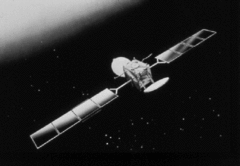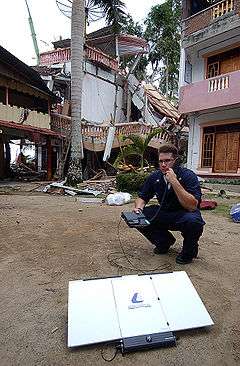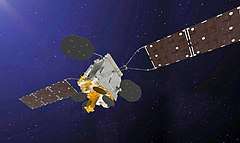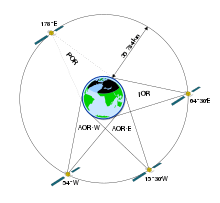Inmarsat
Inmarsat (LSE: ISAT) is a British satellite telecommunications company, offering global mobile services. It provides telephone and data services to users worldwide, via portable or mobile terminals which communicate with ground stations through thirteen geostationary telecommunications satellites.[3] Inmarsat's network provides communications services to a range of governments, aid agencies, media outlets and businesses (especially in the shipping, airline and mining industries) with a need to communicate in remote regions or where there is no reliable terrestrial network. The company was listed on the London Stock Exchange until it was acquired by Connect Bidco, a consortium consisting of Apax Partners, Warburg Pincus, the CPP Investment Board and the Ontario Teachers' Pension Plan, in December 2019.
 | |
| Private company | |
| ISIN | GB00B09LSH68 |
| Industry | Satellite communication |
| Founded | 1979 |
| Headquarters | London, England, UK |
Key people |
|
| Revenue | US$1,465.2 million (2018)[1] |
| US$288.7 million (2018)[1] | |
| US$125.0 million (2018)[1] | |
Number of employees | 1,500 (2019)[2] |
| Website | www |


History
Origins
The present company originates from the International Maritime Satellite Organization (INMARSAT), a non-profit intergovernmental organization established in 1979 at the behest of the International Maritime Organization (IMO)—the United Nations' maritime body—and pursuant to the Convention on the International Maritime Satellite Organization, signed by 28 countries in 1976.[4][5] The organisation was created to establish and operate a satellite communications network for the maritime community.[4][6] In coordination with the International Civil Aviation Organization in the 1980s, the convention governing INMARSAT was amended to include improvements to aeronautical communications, notably for public safety.[4] The member states owned varying shares of the operational business.[5] The main offices were originally located in the Euston Tower, Euston Road, London.[7]
Privatisation
In the mid-1990s, many member states were unwilling to invest in improvements to INMARSAT's network, especially owing to the competitive nature of the satellite communications industry, while many recognized the need to maintain the organization's older systems and the need for an intergovernmental organization to oversee public safety aspects of satellite communication networks.[5] In 1998, an agreement was reached to modify INMARSAT's mission as an intergovernmental organization and separate and privatize the organization's operational business, with public safety obligations attached to the sale.[5]
In April 1999, INMARSAT was succeeded by the International Mobile Satellite Organization (IMSO) as an intergovernmental regulatory body for satellite communications, while INMARSAT's operational unit was separated and became the UK-based company Inmarsat Ltd.[4][8] The IMSO and Inmarsat Ltd. signed an agreement imposing public safety obligations on the new company.[4] Inmarsat was the first international satellite organization that was privatized.[5]
In 2005, Apax Partners and Permira bought shares in the company. The company was also first listed on the London Stock Exchange in that year.[9] In March 2008, it was disclosed that U.S. hedge fund Harbinger Capital owned 28% of the company.[10] In 2009, Inmarsat completed the acquisition of satellite communications provider Stratos Global Corporation (Stratos)[11] and acquired a 19-percent stake in SkyWave Mobile Communications Inc., a provider of Inmarsat D+/IsatM2M network services which in turn purchased the GlobalWave business from TransCore.[12] Inmarsat won the 2010 MacRobert Award for its Broadband Global Area Network (BGAN) service.[13][14]
Inmarsat at first provided services using Marisat[15] and MARECS,[16] which were launched by the US Navy and ESA respectively. In the early 1990s Inmarsat launched its first dedicated satellite constellation, Inmarsat-2. These satellites provided the Inmarsat-A service for maritime uses.[17] Between 1996 and 1998 Inmarsat's second constellation, Inmarsat-3, was launched. Consisting of 5 geostationary L-band satellites the constellation provides the Inmarsat-B and Inmarsat-C services, primarily providing low bandwidth communications and safety services for global shipping.[18] Following privatization in 1999 Inmarsat developed and launched the first satellite communications system offering global coverage, BGAN.[19] This service was provided initially through the three Inmarsat-4 satellite launched between 2005 and 2008, and was then extended with the addition of Alphasat in 2013.[20] In the 2010s Inmarsat began development of the High Throughput Satellite (HTS) constellation Global Xpress, operating in the Ka band portion of the spectrum. Global Xpress, launched in 2015, offers global satellite capacity to various markets including shipping and aviation. Global Xpress also marks a significant expansion of Inmarsat's commercial operations in the aviation markets.[21][22] In 2017 Inmarsat launched its first S-band satellite, intended to provide (in association with an LTE ground network) inflight internet access across Europe.[23] In March 2018, Inmarsat partnered with Isotropic Systems to develop a state-of-the-art, all electronic scanning antenna intended to be used with the Global Xpress network.[24]
On 20 September 2018, Inmarsat announced its strategic collaboration with Panasonic Avionics Corporation for an initial ten-year period, to provide in-flight broadband for commercial airlines. Inmarsat will be the exclusive provider of Panasonic for connectivity using the Ka-band satellite signal.[25] Inmarsat will now be offering Panasonic's portfolio of services to its commercial aviation customers.[26]
Malaysia Airlines Flight 370
In March 2014, Malaysia Airlines Flight 370 disappeared with 239 passengers and crew en route from Kuala Lumpur to Beijing. After turning away from its planned path and disappearing from radar coverage, the aircraft's satellite data unit remained in contact with Inmarsat's ground station in Perth via the IOR satellite (Indian Ocean Region, 64° East). The aircraft used Inmarsat's Classic Aero satellite phone service. Analysis of these communications by Inmarsat and independently by other agencies determined that the aircraft flew into the southern Indian Ocean and was used to guide the search for the aircraft.[27][28]
Takeover offer
In March 2019 the company's board agreed to recommend a takeover offer of $3.4 billion from Connect Bidco, a consortium consisting of Apax Partners, Warburg Pincus, the CPP Investment Board and the Ontario Teachers' Pension Plan.[29] On 9 October 2019, Bloomberg reported that the UK government was set to approve the takeover with the final consultation for the deal set to conclude on 24 October.[30] In November 2019, Inmarsat rejected an eleventh-hour effort to derail its $6bn sale to a private equity consortium in which it was accused of ignoring a potential boost to the company's value. Oaktree argued that the recommended offer for Inmarsat failed to take account of the potential value of spectrum assets used by Inmarsat’s US partner Ligado.[31] Inmarsat delisted from London Stock Exchange, as the private equity funds took control of the company, on 5 December 2019; at the time, Inmarsat was operating 14 geostationary communications satellites.[32][33]
Operations
The Inmarsat head office is at Old Street Roundabout in the London Borough of Islington.[34] Aside from its commercial services, Inmarsat provides global maritime distress and safety services (GMDSS) to ships and aircraft at no charge, as a public service.[35]
Services include traditional voice calls, low-level data tracking systems, and high-speed Internet and other data services as well as distress and safety services. The BGAN network provides GPRS-type services at up to 800 kbit/s via an IP satellite modem the size of a notebook computer,[36] while the Global Xpress network offers up to 50 Mbit/s via antennas as small as 60 cm.[37] Other services provide mobile Integrated Services Digital Network (ISDN) services used by the media for live reporting on world events via videophone,[38] and inflight Internet access via the European Aviation Network.[23]
The price of a call via Inmarsat has now dropped to a level where they are comparable to, and in many cases lower than, international roaming costs, or hotel phone calls. Voice call charges are the same for any location in the world where the service is used. Tariffs for calls to Inmarsat country codes vary, depending on the country in which they are placed. Inmarsat primarily uses country code 870 (see below).[39] Newer Inmarsat services use an IP technology that features an always-on capability where the users are only charged for the amount of data they send and receive, rather than the length of time they are connected.[40] In addition to its own satellites, Inmarsat has a collaboration agreement with ACeS regarding handheld voice services.[41]
Coverage

There are three types of coverage related to each Inmarsat I-4 satellite.[42]
- Global beam coverage
- Each satellite is equipped with a single global beam that covers up to one-third of the Earth's surface, apart from the poles. Overall, global beam coverage extends from latitudes of −82 to +82 degrees regardless of longitude.
- Regional spot beam coverage
- Each regional beam covers a fraction of the area covered by a global beam, but collectively all of the regional beams offer virtually the same coverage as the global beams. Use of regional beams allow user terminals (also called mobile earth stations) to operate with significantly smaller antennas. Regional beams were introduced with the I-3 satellites. Each I-3 satellite provides four to six spot beams; each I-4 satellite provides 19 regional beams.
- Narrow spot beam coverage
- Narrow beams are offered by the three Inmarsat-4 satellites. Narrow beams vary in size, tend to be several hundred kilometers across. The narrow beams, while much smaller than the global or regional beams, are far more numerous and hence offer the same global coverage. Narrow spot beams allow yet smaller antennas and much higher data rates. They form the backbone of Inmarsat's handheld (GSPS) and broadband services (BGAN). This coverage was introduced with the I-4 satellites. Each I-4 satellite provides around 200 narrow spot beams.
- Global Xpress (I-5)
The Inmarsat I-5 satellites provide global coverage using four geostationary satellites.[43] Each satellite supports 89 beams, giving a total coverage of approximately one-third of the Earth's surface per satellite. In addition, 6 steerable beams are available per satellite, which may be moved to provide higher capacity to selected locations.[44]
On 26 November 2019, the first satellite to extend the original 4 satellite first generation Global Xpress constellation was launched from Guiana Space Centre by an Ariane 5 rocket.[45]
Satellites

| Satellite | Coverage | Longitude | Vehicles | Launch date (GMT) | Services / notes |
|---|---|---|---|---|---|
| Marisat series | |||||
| Marisat F1 | 106° west | Delta 2914 | 19 February 1976 | Decommissioned 1997 | |
| Marisat F2 | 33.9º west | Delta 2914 | 14 October 1976 | Transferred to Intelsat in 2004, decommissioned in 2008 | |
| Marisat F3 | 345° east | Delta 2914 | 10 June 1976 | Decommissioned | |
| MARECS series | |||||
| MARECS-A | Ariane 1 | 20 December 1981 | |||
| MARECS-B | - | Ariane 1 | 9 September 1982 | Launch failure | |
| MARECS-C | Ariane 3 | 10 November 1984 | |||
| Inmarsat-2 series | |||||
| Inmarsat-2 F1 | Delta II 6925 | 30 October 1990 | Decommissioned 19 April 2013 Previous record holder for mission lifespan[47] | ||
| Inmarsat-2 F2 | POR | 143° east | Delta II 6925 | 8 March 1991 | Decommissioned Dec 2014 World record for mission lifespan[47] |
| Inmarsat-2 F3 | Ariane 44L | 16 December 1991 | Decommissioned 2006 | ||
| Inmarsat-2 F4 | Ariane 44L | 15 April 1992 | Decommissioned 2012 | ||
| Inmarsat-3 series | |||||
| Inmarsat-3 F1 | IOR | 64.5° east | Atlas IIA | 3 April 1996 | Existing and evolved services only |
| Inmarsat-3 F2 | AOR-E | 15.5° west | Proton-K/DM1 | 6 September 1996 | Existing and evolved services only |
| Inmarsat-3 F3 | POR | 178.2° east | Atlas IIA | 18 December 1996 | Existing and evolved services only |
| Inmarsat-3 F4 | AOR-W | 54° west | Ariane 44L | 3 June 1997 | Existing and evolved services only |
| Inmarsat-3 F5 | I-3 Europe, Middle-East, Africa | 24.6° east | Ariane 44LP | 4 February 1998 | Various leases |
| Inmarsat-4 series | |||||
| Inmarsat-4 F1[48] | I-4 Asia-Pacific | 143.5° east | Atlas V 431 | 11 March 2005 | BGAN family, SPS and lease services |
| Inmarsat-4 F2[49] | I-4 Middle-East, Asia | 64.4° east | Zenit-3SL | 8 November 2005 | BGAN family, SPS and lease services, FleetBroadband, SwiftBroadband
Transferred from 25° east to 63° east in mid-2015[50] |
| Inmarsat-4 F3[51] | I-4 Americas | 98° west | Proton-M/Briz-M | 18 August 2008 | BGAN family and lease services |
| Inmarsat-4A F4 (AlphaSat)[52] | I-4 Europe, Middle-East, Africa | 24.8° east | Ariane 5 ECA | 25 July 2013 | BGAN family, SPS and lease services |
| Inmarsat-5 (GX) series[53][54] | |||||
| Inmarsat-5 F1 (GX-1)[55][56] | I-5 Europe, Middle East, Africa | 62.6° east | Proton-M/Briz-M | 8 December 2013 | Ka-Band global data services, Global Xpress |
| Inmarsat-5 F2 (GX-2)[57] | I-5 Americas | 55° west | Proton-M/Briz-M | 2 February 2015 | Ka-Band global data services, Global Xpress |
| Inmarsat-5 F3 (GX-3)[58] | I-5 Pacific, Asia, West Americas | 179.6° east | Proton-M/Briz-M | 28 August 2015 | Ka-Band global data services, Global Xpress |
| Inmarsat-5 F4 (GX-4)[59] | I-5 Europe + in-orbit spare | 56.5° east | Falcon 9 FT | 15 May 2017[60] | Ka-Band global data services, Global Xpress |
| Inmarsat-5 F5 (GX-5) | First of additional Global Xpress satellites | 11° east | Ariane 5 ECA | 26 November 2019[45] | Ka-Band global data services, first Global Xpress satellite after the 4 first generation satellites |
| European Aviation Network | |||||
| Inmarsat S EAN (Hellas Sat 3)[61] | Europe | 39° east | Ariane 5 | 28 June 2017 | S-band services for European aviation |
Country codes
The permanent telephone country code for calling Inmarsat destinations is:[39]
- 870 SNAC (Single Network Access Code)
The 870 number is an automatic locator; it is not necessary to know to which satellite the destination Inmarsat terminal is logged-in. SNAC is now usable by all Inmarsat services.
Country codes phased out on 31 December 2008 were
- 871 Atlantic Ocean Region – East (AOR-E)
- 872 Pacific Ocean Region (POR)
- 873 Indian Ocean Region (IOR)
- 874 Atlantic Ocean Region – West (AOR-W)
Networks

Inmarsat has developed a series of networks providing certain sets of services (most networks support multiple services). They are grouped into two sets, existing and evolved services, and advanced services. Existing and evolved services are offered through land earth stations which are not owned nor operated by Inmarsat, but through companies which have a commercial agreement with Inmarsat. Advanced services are provided via distribution partners but the satellite gateways are owned and operated by Inmarsat directly.
High Throughput Services
- Global Xpress: Since 2015 Inmarsat has offered high throughput services through the Global Xpress network. This service provides an IP based global service of up to 50 Mbit/s downlink and 5 Mbit/s uplink. Services are provided for maritime, aviation, government and enterprise markets.[62] Global Xpress is supported by the existing BGAN L-band network, and services are offered using a combination of the two networks to increase availability and reliability.[63] In March 2018, Inmarsat partnered with Isotropic Systems to develop all-electronic scanning antenna intended to be used with the Global Xpress network.[24]
- European Aviation Network: Inmarsat is also planning to offer aviation services through the European Aviation Network, developed in partnership with Deutsche Telekom. The European Aviation Network uses a ground-based LTE network and an Inmarsat S-band satellite to provide 50Gbit/s capacity to aircraft in European airspace. The project faces a number of legal and regulatory challenges.[64] In March 2018, Inmarsat stated that commercial service would begin in 2018.[65]
Advanced services
The "BGAN Family" is a set of IP-based shared-carrier services, as follows:[66]
- BGAN: Broadband Global Area Network for use on land. BGAN uses the I-4 satellites to offer a shared-channel IP packet-switched service of up to 800 kbit/s (uplink and downlink speeds may differ and depend on terminal model) and a streaming-IP service from 32 kbit/s up to X-Stream data rate (services depend on terminal model). Most terminals also offer circuit-switched Mobile ISDN services at 64 kbit/s and even low speed (4.8 kbit/s) voice etc. services. BGAN service is available globally on all I4 satellites.
- FleetBroadband (FB): A maritime service, FleetBroadband is based on BGAN technology, offering similar services and using the same infrastructure as BGAN. A range of Fleet Broadband user terminals are available, designed for fitting on ships.
- SwiftBroadband (SB): An aeronautical service, SwiftBroadband is based on BGAN technology and offers similar services. SB terminals are specifically designed for use aboard commercial, private, and military aircraft.
M2M communications
The "BGAN M2M Family" is a set of IP-based services designed for long-term machine-to-machine management of fixed assets, as follows:[67]
- BGAN M2M: Which was launched at the beginning of January 2012, will deliver a global, IP-based low-data rate service, for users needing high levels of data availability and performance in permanently unmanned environments. Ideally suited for high-frequency, very low-latency data reporting, BGAN M2M will prove extremely attractive for monitoring fixed assets such as pipelines and oil well heads, or backhauling electricity consumption data within a utility.
- IsatM2M: IsatM2M is a global, short burst data, store and forward service that will deliver messages of 10.5 or 25.5 bytes in the send direction, to 100 bytes in the receive direction. The service is delivered to market via two partners - SkyWave Mobile Communications and Honeywell Global Tracking.
- IsatData Pro: IsatData Pro is a global satellite data service designed for two-way text and data communications with remote assets and has the capability to exchange large amounts of data quickly (To mobile: 10kBytes / From mobile: 6.4kBytes with typical delivery time at 15 sec.) This service is used in mission-critical applications and is used in everything from managing trucks, fishing vessels and oil & gas and heavy equipment, to text message remote workers and security applications. It is provided by SkyWave Mobile Communications Inc, now part of Orbcomm.
Global voice services
The company offers portable and fixed phone services as follows:[68]
- IsatPhone 2: IsatPhone 2 is Inmarsat's own-designed and manufactured robust mobile satellite phone, offering clear voice telephony. It also comes with a variety of data capabilities, including SMS, short message emailing and GPS look-up-and-send, as well as supporting a data service of up to 20kbit/s.[69]
- IsatPhone Link: IsatPhone Link is a low-cost, fixed, global satellite phone service. It provides essential voice connectivity for those working or living in areas without cellular coverage and also comes with a variety of data capabilities.
- FleetPhone: Inmarsat's FleetPhone service is a fixed phone service ideal for use on smaller vessels where voice communications is the primary requirement or on vessels where additional voice lines are needed. It provides a low-cost, global satellite phone service option for those working or sailing outside cellular coverage.
Existing and evolved services
They are based on older technologies, as follows:[70]
- Aeronautical (Classic Aero): provides analog voice/fax/data services for aircraft. Three levels of terminals, Aero-L (Low Gain Antenna) primarily for packet data including ACARS and ADS, Aero-H (High Gain Antenna) for medium quality voice and fax/data at up to 9600 bit/s, and Aero-I (Intermediate Gain Antenna) for low quality voice and fax/data at up to 2400 bit/s. Note, there are also aircraft rated versions of Inmarsat-C and mini-M/M4. The aircraft version of GAN is called Swift 64 (see below).
- Inmarsat-B: service was retired on 30 December 2016.[71] It provided digital voice services, telex services, medium speed fax/data services at 9.6 kbit/s and high speed data services at 56, 64 or 128 kbit/s. There was also a 'leased' mode for Inmarsat-B available on the spare Inmarsat satellites.
- Inmarsat-C: effectively this is a "satellite telex" terminal with low-speed all-digital (transmission bit rate 1200bit/s and information bit rate of 600 bit/s) store-and-forward, polling etc. capabilities. Certain models of Inmarsat-C terminals are also approved for usage in the global maritime distress and safety services (GMDSS) system, equipped with GPS.
- Inmarsat-M: provides voice services at 4.8 kbit/s and medium speed fax/data services at 2.4 kbit/s. It paved the way towards Inmarsat-Mini-M. Service has been closed.
- Mini-M: provides voice services at 4.8 kbit/s and medium speed fax/data services at 2.4 kbit/s. One 2.4kbit/s channel takes up 4.8kbit/s on the satellite. Service was closed early January 2017
- GAN (Global Area Network): provides a selection of low speed services like voice at 4.8 kbit/s, fax & data at 2.4 kbit/s, ISDN like services at 64 kbit/s (called Mobile ISDN) and shared-channel IP packet-switched data services at 64 kbit/s (called Mobile Packet Data Service or MPDS, formerly Inmarsat Packet Data Service – IPDS). GAN is also known as "M4". Service was closed early in January 2017.
- Fleet: actually a family of networks that includes the Inmarsat-Fleet77, Inmarsat-Fleet55 and Inmarsat-Fleet33 members (The numbers 77, 55 and 33 come from the diameter of the antenna in centimeters). Much like GAN, it provides a selection of low speed services like voice at 4.8 kbit/s, fax/data at 2.4 kbit/s, medium speed services like fax/data at 9.6 kbit/s, ISDN like services at 64 kbit/s (called Mobile ISDN) and shared-channel IP packet-switched data services at 64 kbit/s (called Mobile Packet Data Service or MPDS - see below). However, not all these services are available with all members of the family. The latest service to be supported is Mobile ISDN at 128 kbit/s on Inmarsat-Fleet77 terminals.
- Swift 64: Similar to GAN, providing voice, low rate fax/data, 64kbit/s ISDN, and MPDS services, for private, business, and commercial aircraft. Swift 64 is often sold in a multi-channel version, to support several times 64kbit/s.
- Inmarsat D/D+/IsatM2M: Inmarsat's version of a pager, although much larger than terrestrial versions. Some units are equipped with GPS. The original Inmarsat-D terminals were one-way (to mobile) pagers. The newer Inmarsat-D+ terminals are the equivalent of a two-way pager. The main use of this technology nowadays is in tracking trucks and buoys and SCADA applications.
- MPDS (Mobile Packet Data Service): Previously known as IPDS, this is an IP-based data service in which several users share a 64kbit/s carrier in a manner similar to ADSL. MPDS-specific terminals are not sold; rather, this is a service which comes with most terminals that are designed for GAN, Fleet, and Swift64.
- IsatPhone: provides voice services at 4.8 kbit/s and medium speed fax/data services at 2.4 kbit/s. This service emerged from a collaboration agreement with ACeS, and is available in the EMEA and APAC satellite regions. Coverage is available in Africa, the Middle-East, Asia and Europe, as well as in maritime areas of the EMEA and APAC coverage.
New projects underway
European Aviation Network
On 30 June 2008, the European Parliament and the Council adopted the European's Decision to establish a single selection and authorisation process (ESAP – European S-band Application Process) to ensure a coordinated introduction of mobile satellite services (MSS) in Europe. The selection process was launched in August 2008 and attracted four applications by prospective operators (ICO, Inmarsat, Solaris Mobile (now EchoStar Mobile), TerreStar).[72][73]
In May 2009, the European Commission selected two operators, Inmarsat Ventures and Solaris Mobile, giving these operators "the right to use the specific radio frequencies identified in the Commission's decision and the right to operate their respective mobile satellite systems". EU Member States now have to ensure that the two operators have the right to use the specific radio frequencies identified in the Commission's decision and the right to operate their respective mobile satellite systems for 18 years from the selection decision. The operators are compelled to start operations within 24 months (May 2011) from the selection decision.[74][75][76][77]
Inmarsat's S-band satellite programme will deliver mobile multimedia broadcast, mobile two-way broadband telecommunications and next-generation MSS services across all member states of the European Union and as far east as Moscow and Ankara by means of a hybrid satellite/terrestrial network. It was built by Thales Alenia Space and launched in 2017.[78] The complementary ground network consists of around 300 LTE base stations constructed by Deutsche Telekom.[79]
The European Aviation Network faces a number of legal challenges. This includes a challenge from Viasat alleging unfair bidding practices and a misuse of spectrum[80] and a ruling by the Belgian telecommunications regulator revoking permission for the use of the ground network in Belgium.[81]
Global Xpress Expansion
Inmarsat ordered a fifth Global Xpress satellite from Thales Group. The satellite launched 26 November 2019 from Guiana Space Centre aboard an Ariane 5 rocket.[45] The satellite has been described as a 'very high throughput satellite', and provides services to the Middle East, India and Europe.[82] CEO Rupert Pearce has also indicated that Inmarsat is planning further expansion of the Global Xpress network in the future. Trials of new technologies have demonstrated bandwidths of 330 Mbit/s over the existing Global Xpress network, far in excess of the currently marketed 50 Mbit/s.[83]
Polar Coverage
To provide GX coverage to the growing number of users in the Arctic region, Inmarsat plans to improve GlobalXpress connectivity to above 65° North.[53]
Two high-capacity, multi-beam payloads GX-10A and GX-10B will be placed in Highly Elliptical Orbits (HEO) to ensure reliable coverage. Inmarsat is working in partnership with Space Norway HEOSAT in the Arctic Satellite Broadband Mission. The satellites carrying the Inmarsat payload plan to be manufactured by Northrop Grumman Innovation Systems. Launch for GX-10A and 10B are scheduled for 2022.[84]
Inmarsat-6
At the end of 2015 Inmarsat ordered two sixth generation satellites from Airbus. These satellites will offer both Ka and L band payloads and will provide additional capacity to the existing BGAN and Global Xpress networks.[85] In 2017 it was announced that the first of these satellites will be launched by MHI in 2020.[86]
IRIS and ICE
Inmarsat is participating in two ESA ARTES programs, IRIS and ICE:
- IRIS is a project to improve tracking of aircraft, and to improve communications between aircraft and air traffic controllers. Inmarsat will provide high capacity satellite communications links for aircraft, and improve detection of aircraft locations in time and space.[87][88]
- ICE (Inmarsat Communications Evolution) is a partnership with industrial partners intended to identify innovative technologies that can expand and enhance the capabilities of the next generation of satellite communications.[89]
Issues
INMARSAT and Iridium frequency bands abut each other at 1626.5 MHz thus each satcom radio has the ability to interfere with the other. Usually, the far more powerful INMARSAT radio disrupts the Iridium radio up to 10–800 metres away.[90]
See also
- Mobile-satellite service
- Satellite phone
- AeroMobile
- DVB-SH
- Globalstar
- Globalsat Group
- Intersputnik
- Iridium Communications
- Librestream
- Maritime safety information
- O3b Networks
- OnAir (telecommunications)
- Orbcomm
- Radiotelephone
- SES Broadband for Maritime
- Sky and Space Global
- Thuraya
- Wideband Global SATCOM (WGS)
References
- "Annual Results 2018" (PDF). investors.inmarsat.com. Retrieved 18 March 2019.
- "Our offices". Inmarsat. Retrieved 18 March 2019.
- "Inmarsat-About Us". www.inmarsat.com.
- Proposed Amendments to the Convention on the International Mobile Satellite Organization (IMSO), International Civil Aviation Organization, 14 May 2003, archived from the original on 7 June 2011
- Sagar, David (1999). Harris, R. A. (ed.). "The privatisation of INMARSAT: Special problems". International Organisations and Space Law, Proceedings of the Third ECSL Colloquium, Perugia, Italy, 6–7 May 1999: 127–142. Bibcode:1999ESASP.442..127S.
- Jonathan Higgins, "Satellite Newsgathering", Focal Press, 2007, p. 204 ISBN 978-0-240-51973-9
- Godwin, Matthew (5 December 2007). "Interview with Roy Gibson" (PDF). Oral History of Europe in Space. European Space Agency. p. 5. Retrieved 1 June 2016.CS1 maint: ref=harv (link)
- Jonathan Higgins p. 207
- "Dollars & Sense". Satellitetoday.com. 2 January 2006. Retrieved 18 April 2011.
- "Private equity orbits Inmarsat". Investorschronicle.co.uk. 7 March 2008. Retrieved 18 April 2011.
- "Inmarsat buys Stratos Global". Washington Business Journal. 16 April 2009. Retrieved 28 March 2015.
- Editorial, Reuters. "Inmarsat to take stake in tracking co SkyWave". U.K. Retrieved 23 March 2018.
- "Inmarsat grabs the MacRobert engineering prize". 8 June 2010. Retrieved 8 June 2010.
- "Making things better – finalists announced for Britain's top engineering award". BBC News. 10 May 2010. Retrieved 8 June 2010.
- "Inmarsat-A Ends Service After 32 Years". comara.org.
- "The launch of MARECS B2". www.esa.com.
- "Inmarsat-2 F1, 2, 3, 4". space.skyrocket.de.
- "Inmarsat C provides two-way data and messaging communication services". www.inmarsat.com.
- "ESA/Inmarsat agreement to improve satellite mobile phone and data services". www.esa.int.
- "about-usour-satellites". www.inmarsat.com.
- "Global Xpress". www.inmarsat.com.
- "GX Aviation". www.inmarsat.com.
- "European Aviation Network". www.inmarsat.com.
- "Inmarsat Partners with Isotropic Systems to Develop Next-Gen Ka-band Mobility Antenna". 13 March 2018. Retrieved 4 June 2018.
- "Inmarsat and Panasonic partner on in-flight connectivity". Reuters. Retrieved 20 September 2018.
- "Inmarsat, Panasonic Announce Strategic Collaboration - Quick Facts". Retrieved 20 September 2018.
- "UK firm behind Malaysia Airlines flight MH370 breakthrough". BBC News. 24 March 2014.
- Ashton, Chris; Bruce, Alan Shuster; Colledge, Gary; Dickinson, Mark (14 September 2014). "The Search for MH370". Journal of Navigation. Royal Institute of Navigation. 68: 1–22. doi:10.1017/S037346331400068X. Lay summary.
- "UK satellite operator Inmarsat agrees $3.4bn takeover". The Guardian. 25 March 2019. Retrieved 25 August 2019.
- "Bloomberg - Are you a robot?". www.bloomberg.com. Retrieved 10 October 2019.
- Fildes, Nic (5 November 2019). "Inmarsat rejects activist effort to thwart $6bn takeover". www.ft.com. Retrieved 9 December 2019.
- "Inmarsat delists from stock exchange after buyout". Space News. 5 December 2019. Retrieved 5 December 2019.
- "Private equity giants take control of Inmarsat after hedge funds fold". The Telegraph. 3 December 2019. Retrieved 5 December 2019.
- "Privacy Policy." Immarsat. Retrieved on 26 March 2014. "99 City Road London EC1Y 1AX United Kingdom"
- "GMDSS weather". Weather.gmdss.org. Retrieved 18 April 2011.
- "BGAN-HDR". www.inmarsat.com.
- "Global Mobile Broadband" (PDF). Inmarsat. Retrieved 23 March 2018.
- "Transforming satellite newsgathering" (PDF). Archived from the original (PDF) on 13 July 2011. Retrieved 18 April 2011.
- "one world, one number". Inmarsat. Archived from the original on 13 July 2011. Retrieved 18 April 2011.
- "BGAN provides "eyes and ears" for oil rigs" (PDF). Archived from the original (PDF) on 13 July 2011. Retrieved 18 April 2011.
- "Low-Cost Hand-Held And Fixed Voice Services From Inmarsat And ACeS - Marine-electronics.eu". marine-electronics.eu.
- "How the Inmarsat satellite system works". Wcclp.com. Archived from the original on 5 May 2011. Retrieved 18 April 2011.
- "Inmarsat Global Xpress Coverage" (PDF). www.inmarsat.com.
- "Maritime Solution Overview-Shane Rossbacher" (PDF). thedigitalship.com.
- Henry, Caleb (26 November 2019). "Ariane 5 launches satellites for Egypt, Inmarsat". SpaceNews. Retrieved 26 November 2019.
- "N2YO". www.n2yo.com. Retrieved 7 December 2015.
- "Airbus-built Inmarsat 2 F2 Satellite Breaks World Record for Mission Lifespan". Via Satellite. 22 December 2014. Retrieved 1 August 2015.
- "Inmarsat-4 f1". National Space Science Data Center.
- "All go for giant comms satellite". BBC News. 8 November 2005. Retrieved 18 April 2011.
- Caleb, Henry (10 June 2015). "Inmarsat-4 F2 Satellite Relocating to Cover Middle East and Asia". Via Satellite. Retrieved 7 December 2015.
- "ILS Proton successfully launches Inmarsat-4 F3 satellite". International Launch Services. 19 August 2008. Archived from the original on 23 September 2008.
- "Flawless launch of Alphasat". ESA. July 2013.
- "Our satellites". Inmarsat. Retrieved 10 January 2020.
- "Inmarsat-5 F1, 2, 3, 4 (GX 1, 2, 3, 4)". space.skyrocket.de. Retrieved 10 January 2020.
- "Inmarsat begins Global Xpress roll-out". BBC News. 9 December 2013.
- "Inmarsat-5 F1". International Launch Services. 8 December 2013.
- "Inmarsat launches second Global Xpress satellite". BBC News. 2 February 2015.
- "I-5 F3: the mission". Inmarsat inc. 29 August 2015.
- "Inmarsat to purchase fourth Inmarsat-5 satellite from Boeing" (Press Release). Inmarsat. 7 October 2013. Retrieved 9 March 2015.
- "Inmarsat-5 F4 Mission" (PDF). Space X. Retrieved 8 February 2018.
- "Inmarsat Confirms Successful Launch". www.inmarsat.com.
- "Global Xpress - Seamless Satellite Broadband - Inmarsat". www.inmarsat.com.
- "Global Express" (PDF). www.inmarsat.com. 2015.
- "Belgian court punches hole in Inmarsat's European Aviation Network - SpaceNews.com". SpaceNews.com. 21 March 2018. Retrieved 23 March 2018.
- "Successful test flight shows EAN on track to launch". Inmarsat Aviation. Retrieved 26 March 2018.
- "Inmarsat services". Inmarsat.com. Retrieved 18 April 2011.
- "BGAN M2M". Inmarsat. Retrieved 28 March 2015.
- "Voice". Inmarsat. Retrieved 28 March 2015.
- "IsatPhone 2 Overview" (PDF). www.inmarsat.com. June 2015.
- "our services at a glance". Inmarsat. Archived from the original on 13 July 2011. Retrieved 18 April 2011.
- "Inmarsat B". Inmarsat. Retrieved 30 June 2019.
- "Commission boost for mobile satellite services paves the way for EU-wide high speed data communications". Europa.eu. 22 August 2007. Retrieved 18 April 2011.
- "New Satellites for Europe: Commission starts selection procedure for operators of pan-European mobile satellite services". Europa.eu. Retrieved 18 April 2011.
- "European Commission paves the way for European mobile satellite services" (Press release). European Commission. 14 May 2009.
- "Mobile Satellite Services in Europe: Frequently Asked Questions". Europa.eu. Retrieved 18 April 2011.
- Felix, Bate (14 May 2009). "Inmarsat and Solaris win EU spectrum rights". Reuters. Retrieved 18 April 2011.
- "Pan-European numbers and services". Ec.europa.eu. Retrieved 18 April 2011.
- "EuropaSat / HellasSat 3". skyrocket.de. Retrieved 25 May 2015.
- "How we did it: the European Aviation Network is one giant step closer". Inmarsat Aviation. Retrieved 26 March 2018.
- "In-flight WiFi battle over Europe takes off". Financial Times.
- "Belgian court punches hole in Inmarsat's European Aviation Network - SpaceNews.com". 21 March 2018.
- "Inmarsat orders fifth Global Xpress satellite from Thales Alenia Space - SpaceNews.com". 2 June 2017.
- "Inmarsat CEO hints at more advanced Global Xpress satellites - SpaceNews.com". 7 March 2017.
- "Northrop Grumman to build two triple-payload satellites for Space Norway, SpaceX to launch". SpaceNews.com. 3 July 2019. Retrieved 10 January 2020.
- "Inmarsat awards contract to airbus". www.inmarsat.com.
- "MHI launch first Inmarsat 6 satellite". www.inmarsat.com.
- esa. "Satellite Communication for Air Traffic Management (Iris)". www.esa.int.
- "ESA Using Inmarsat for Iris to Open up the Skies - Avionics". www.aviationtoday.com. 7 March 2018.
- "ICE". European Space Agency. Retrieved 23 March 2018.
- "Inmarsat Interference Information". Inmarsat. Archived from the original on 12 September 2014. Retrieved 28 March 2015.